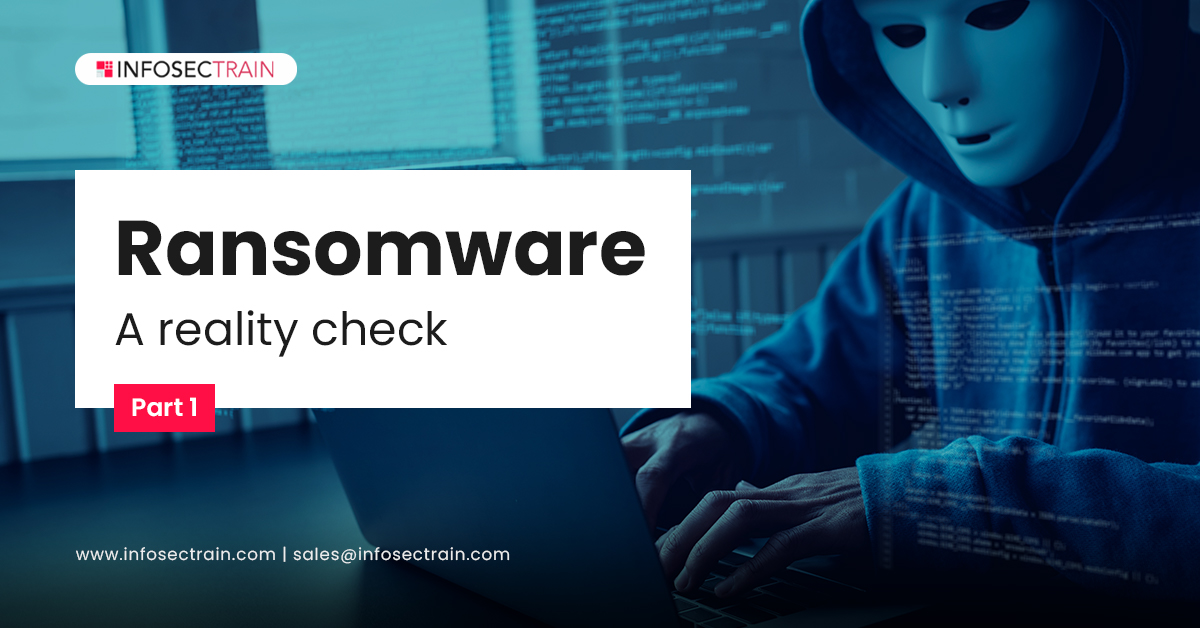Ransomware- A reality check (Part 1)
Ransomware has been the most significant threat for years which has been affected over sectors and remained one of the top risks. The topics covered in the webinar are detailed in this blog for reference.

- Ransomware- A reality check (Part 1)
- Ransomware- A reality check (Part 2)
- Ransomware- A reality check (Part 3)
What is Ransomware?
Ransomware is the type of malicious software or malware that prevents you from accessing your files, networks, or systems. They demand a ransom amount to get your access back.
In 1989, the first-ever ransomware attack happened through an aid trojan that targeted the healthcare industry. It has been carried out through a floppy disk delivered by the postal service as it was symmetric encryption that blocks users from accessing their files. However, the IT specialist had discovered the decryption key and retrieved their access back without paying any ransom amount.
Adam Young and Moti Yung introduced the term Cryptovirology, and it is a field of study on using cryptography to design robust and malicious malware or softwares. They invented the concept of encrypting a file in 1996 at the IEEE security and privacy conference.
An anti-virus analyst could identify the public key that includes malware, but an attacker can determine the corresponding private key. It is because the attacker has created the key pair. This public key acts as a one-way operation on the victim file, encrypting the file. The way to decrypt the file is through the attacker’s corresponding private key. These kinds of attacks can happen through your crypto virus or crypto worm, or crypto trojan, and the preferred method among these is crypto trojan.
Crypto-jacking
During a crypto-jacking attack, the victims’ computers are infected with cryptocurrency mining malware. This malware infects the victim’s system, leverages the victim’s computing power without knowledge, and mines the cryptocurrency. One such incident was Crypto-jacking, which Palo Alto Networks discovered. Many variants are evolving and are the types of extortion.
Triple Extortion Attack
Triple Extortion Attack is an extension of a double extortion attack, but the tactic used might vary. When the attackers have encrypted your file, it remains inaccessible, and they demand ransom extortion. The threat actor could threaten leaking data if not paid the ransom, and they could threaten you with launching a DDoS attack.
The most used medium for this kind of attack is through emails or malvertising advertisements from websites.
Ransomware is evolving, and cyber criminals having low technical capabilities can perform Ransomware attacks. Now, this malware can be made available to buyers like you and me to quote one such group as a quantity ransomware group, and they leaked a playbook on how to launch these ransomware attacks, which is pretty scary.
Top emerging trends in Ransomware
The following are the top emerging trends in Ransomware:
1. Ransomware-as-a-service : It is a subscription that allows members to use the ransomware tool. The beauty of this group is that they can also help you extend your reach and make your attack more distributed in nature. The authorities would have a hard time containing it. The creators of these tools have started asking for a cut percentage on each successful ransom payment, and the average now is 33% that they demand from any successful ransom payment.
2. Attacking the Susceptible-The focus is on weak industries: Attackers have taken advantage of industries badly hit by pandemics, such as healthcare, educational institutions, and government. One of the methods is the remote connection or remote corporate connections. Now personal devices of high net worth individuals are also being targeted by these attacks.
3. The exploitation of Managed Service Providers: If you attack one managed service provider, remember it can open up doors to many of its clients. Hence, the target is managed service providers also. A vulnerable spot is through the remote access tools that are poorly secured or configured.
4. Newer and evolving strains: A huge increase in the number of variants and the complexities are also evolving. So, the defense techniques, few companies have also started using behavioral analysis using AI and ML to detect future events or predictive analytics.
5. Targeting mobile devices: Mobile ransomware variants are also on the increase. The attackers can lock your device, encrypt your files and steal the data, and you have to pay a ransom to use your device again.
These are the major trends of Ransomware attacks that are being spreading over the world. To protect and prevent these ransomware threats, consider advanced protection technologies, Patch regularly, Maintain an in-depth security system, Frequent backups, and proper guidance on Social engineering.
Key types and techniques used in Ransomware
There are many variants, but majorly they are categorized into four types.
1. Encrypting Ransomware: A typical encryption technique used to decrypt or encrypt the ransom needs to be paid.
2. Screen Lockers: It restricts your login or file access, and it also disables your essential computer functions, and it operates at an operating system level.
3. Scareware: It is to scare you that it could be malicious software created to make a false claim about viruses infecting your files or computer devices, and payment is demanded in return to fix the falsified issue. One of the general techniques is a pop-up message that would keep coming up on your screen that your laptop has affected, and you have to make a payment to get rid of it.
4. Doxware: Doxware or leak ware threatens that the group will distribute your personal or sensitive data if the ransom is not paid. Some individuals can go to any extent and give any amount to prevent their data from being leaked in public.








 1800-843-7890 (India)
1800-843-7890 (India)